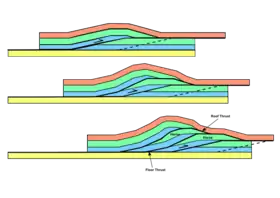Horse (geology)
Horse is the geological technical term used for any block of rock completely separated from the surrounding rock either by mineral veins or fault planes. In mining the term refers to a block of country rock entirely encased within a mineral lode.[1] In structural geology the term was first used to describe the thrust-bounded imbricates found within a thrust duplex.[2] In later literature it has become a general term for any block entirely bounded by faults, whether the overall deformation type is contractional, extensional or strike-slip in nature.[3][4]

Diagram showing development of thrust-bounded horses within a thrust duplex

A horse sits between the walls of this normal fault located near Upheaval Dome, Utah. The fault plane traces from the upper right to the lower left of the image. The horse is the broad lens-shaped feature in the rock defined by the splitting and rejoining of the trace of the fault plane. Some boudinage due to shearing is visible within the horse.
References
- Butler, F.H. 1911. The brecciation of mineral veins.
- Dennis, J.G. 1967. International tectonic dictionary. AAPG Memoir 7, 196pp.
- Root, K.G. 1990. Extensional duplex in the Purcell Mountains of southeastern British Columbia. Geology, 18, 419-421
- Laney, Stephen E; Gates, Alexander E (1996), "Three-dimensional shuffling of horses in a strike-slip duplex: an example from the Lambertville sill, New Jersey", Tectonophysics, 258 (1–4): 53–70, doi:10.1016/0040-1951(95)00173-5
This article is issued from Wikipedia. The text is licensed under Creative Commons - Attribution - Sharealike. Additional terms may apply for the media files.